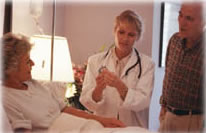


   |
Lentigo - Causes, Symptoms and Treatment
Definition A lentigo is a small, sharply circumscribed, pigmented macule surrounded by normal-appearing skin. Histological findings may include hyperplasia of the epidermis and increased pigmentation of the basal layer. They may occur anywhere on the body and vary in color from tan-brown to black. Viewed under the microscope a lentigo shows an increased number of normal melanocytes. Although lentigo may be part of a genetic disorder, for the most part they are just isolated and unimportant spots. Lentigo are most frequently seen in adults over thirty, and they occur most commonly on sun exposed skin, face, back of hands, arms, chest and lower legs. They are typically tan or brown in color, and are generally flat. Lentigo maligna is mostly seen in patients 50 to 80 years old and accounts for ten to 15 percent of skin cancer cases. Causes
Symptoms
Treatment
| |
Online Doctor || Teeth Care || Contact Us || Diabetes Care || Cellulite Guide || Chemotherapy || Acne Products ||
|
|
(c) Online-family-doctor.com All rights reserved
Disclaimer: Online-family-doctor.com is an information and educational purposes web site only. It is not intended to treat, diagnose, cure, or prevent any disease. Do not rely upon any of the information provided on this site for medical diagnosis or treatment. Please consult your primary health care provider about any personal health concerns. We will not be liable for any complications, or other medical accidents arising from the use of any information on this site.